Today, we released the MCX A14x and A15x series of "all-purpose" microcontrollers. MCX A is part of the larger
MCX portfolio that shares a common Arm®
Cortex®-M33 core platform. MCX was founded with the idea of bringing together the best elements of popular NXP
devices plus new innovative features to provide the next generation of intelligent edge devices.
Scalability is an important pillar of the MCX portfolio.
MCX A Series
serves a significant role in this portfolio, being the go-to for all-purpose devices. It targets a wide range of applications
spanning multiple markets including:
- Industrial Communications
- Smart Metering
- Automation and Control
- Sensors
- Low-Power/Battery Powered Devices
The MCX A14x operates at 48 MHz and the MCX A15x operates at 96MHz. Device package options include 32-pin QFN, 48-pin QFN and a
64-pin LQFP. MCX A parts are IO and pin compatible across the package types, simplifying migration and upgrades. Peripherals are
also common, simplifying software development efforts. Up to 8 pins are capable of 20mA high current drive with a select number
being 5V tolerant.
 MCX A14/A15 Family Block Diagram
MCX A14/A15 Family Block Diagram
For a better experience, download the
block diagram.
MCX A uses a capless LDO power subsystem which can operate from 1.7V to 3.6V. A key part of the MCX A power architecture is its outstanding power efficiency:
- 59 µA/MHz (3V, @25 °C) in active mode running Coremark from internal flash.
- 6.5uA Deep Sleep, 10 µs wake-up with full SRAM retention, 3V @25 °C
- <400nA Deep Power down with 2.78ms Wake
All-Purpose Peripherals with Distinguished IO
An all-purpose device, such as the MCX A, includes all the peripherals you expect. UARTs, SPI , I2C and several timer
subsystems serve as the foundation for traditional applications. However, MCX A also includes some notable additions that set it
apart.
MIPI I3C®: The New I2C
NXP has been an active participant in the implementation the MIPI I3C bus in its microcontroller families. I3C was
developed by the
MIPI alliance to
provide an upgrade to I2C for higher speed two-wire applications. I3C is positioned as an alternative to SPI while
keeping a simple two wire interface between devices on a PCB.
NXP’s support for MIPI I3C spans general-purpose MCUs, to i.MX RT crossover MCUs, to the high-end i.MX applications processors.
 NXP I3C Support
NXP I3C Support
The I3C peripheral in low pin count MCX A devices open up possibilities for new applications such as I3C protocol bridging and
intelligent peripherals with a high-speed two-wire interface.
A Full Speed USB Device Controller and Flexible Boot ROM
MCX A devices include a full-speed USB device controller with onboard PHY. Adding USB further establishes the MCX A as an
all-purpose device, enabling connectivity to PCs and other smart devices. A notable feature of the USB subsystem in MCX A is in-system programming (ISP) via the boot ROM. Products can be field updated using the USB interface.
ISP functionality is built into the MCX A boot ROM. Failed firmware updates can be a problem of the past. The boot ROM ensures
that there is a fallback programming option that is guaranteed to work regardless of the contents of FLASH memory.
It’s important to note that the ISP functions are available over UART, I2C and SPI interfaces. We make using the boot
ROM functions easy via our
MCUXpresso SEC tool, allowing users to
develop their own production programming and field update workflows using an intuitive graphical interface, with the ability to
output command line operations for scripting. Our open-source
Secure Provisioning SDK
(SPSDK) enables advanced users to further customize the command line operations, if desired.
A Rugged Memory Subsystem for Industrial Sensing and Control
There are two notable features in the MCX A memory architecture.
The first is the Low-Power Cache Controller (LPCAC). The LPCAC is a small, but efficient 4KB cache controller attached to the
Arm Cortex-M33 code bus. Data and instructions can be available with a low latency with the LPCAC. Bus availability for other
peripherals, such as DMA, is improved as the processor performance can be decoupled from system memory performance.
This feature can be a critical feature for achieving the best IO and processing performance for sensing and control
applications. If the cache mechanism is not required, the 4KB LPCAC memory can be repurposed as instruction memory. Critical
code and interrupt vectors can be placed in this region for tight timing and control loops.
A subsection of RAM on MCX A has ECC capability which can be used in conjunction with the error reporting module (ERM) for
applications requiring higher reliability.
Motor Control and the Analog Subsystems
The MCX A includes a high-speed 4MSPS ADC along with high-speed comparators that feature an 8-bit reference DAC. The analog
subsystem can be coupled with the motor control subsystem which includes the FlexPWM peripheral.
Coupling connectivity with advanced analog peripherals and motor control subsystem showcases that MCX A is ideal for
applications such as:
- BLDC motor, PMSM and field oriented control
- Precision servo systems and positioning
- Distributed battery management systems (BMS)
Ease of Use Enabled by the MCUXpresso Developer Experience
We strive to offer developers the freedom of choice in how they develop software. At the heart of MCX A is the
MCUXpresso Developer Experience. The MCUXpresso suite of software and tools offers core software development kits (SDKs), integrated development environments
(IDEs) and configuration tooling.
The SDK for MCX A includes low-level peripheral drivers, configuration utilities and middleware such as a USB device stack.
The SDKs are flexible and can be used with a range of IDEs include:
MCX A is well suited for bare metal applications but is RTOS capable. FreeRTOS samples are available in the SDK for MCX A. First
class
Zephyr RTOS support will be upstreamed later in 2024.
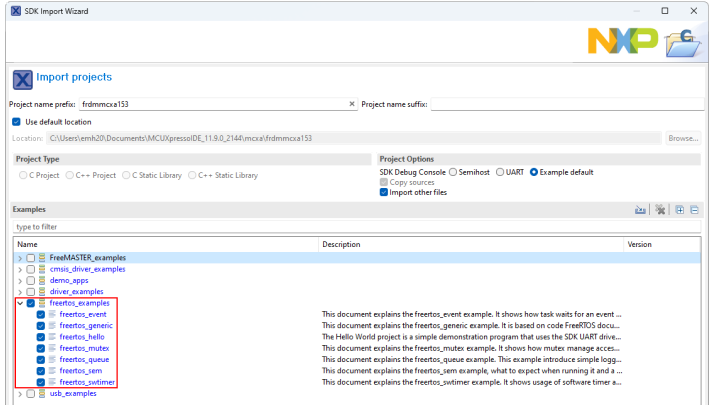 FreeRTOS Samples Available in the SDK
FreeRTOS Samples Available in the SDK
MCX A USB Middleware Support
USB can be complicated, but we offer examples for all of the common use cases. MCUXpresso IDE also includes a sophisticated
configuration tool for generating custom USB device code. The tooling enables developers to quickly build USB devices while
managing all of the boilerplate initialization code and descriptors.
The MCX A MCUXpresso SDK
One method to get the latest SDK package is via the online
MCUXpresso SDK builder.
 MCUXpresso SDK BUILDER with MCX
MCUXpresso SDK BUILDER with MCX
SDKs are also able to be directly fetched from within MCUXpresso IDE or from MCUXpresso for VS Code. In addition to generating a
stand-alone SDK for a particular device, developers can fetch releases directly from
NXP’s GitHub repository.
 MCUXpresso SDK is open source
MCUXpresso SDK is open source
We offer the freedom to develop in a way that supports your preferred workflow.
Support for Modern CI/CD Development Workflows
More embedded projects rely on continuous integration and continuous deployment workflows. IDE-based projects are commonplace
for microcontroller development, but the MCX A tooling also supports command line builds to use in a CI/CD pipeline “out of the
box”. Inside of the SDK are CMake scripts which can be used with your preferred build tools, such as Make, or the fast Ninja build system.
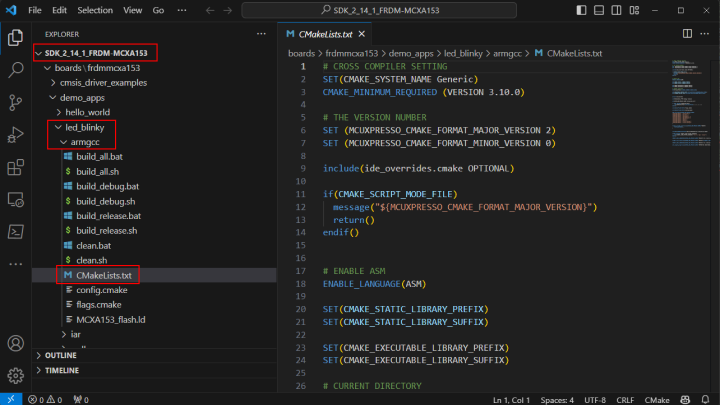 MCX A support CI/CD and command line builds in the SDK
MCX A support CI/CD and command line builds in the SDK
Within the SDK, you will find a top-level CMakeLists.txtscript along with shell scripts to demonstrate how to
kick off a build. It is important to point out the VS Code plugin uses this framework behind the scenes to compile code with a
fast ninja build system. Between the variety of IDEs, an open-source GitHub delivery option and frameworks for professional
CI/CD workflows, users are empowered with significant choice in how to approach software development.
Rapid Prototyping with FRDM-MCXA153 Development Board
With the release of the MCX A series, we are also bringing back the
FRDM development platform
with enhancements.
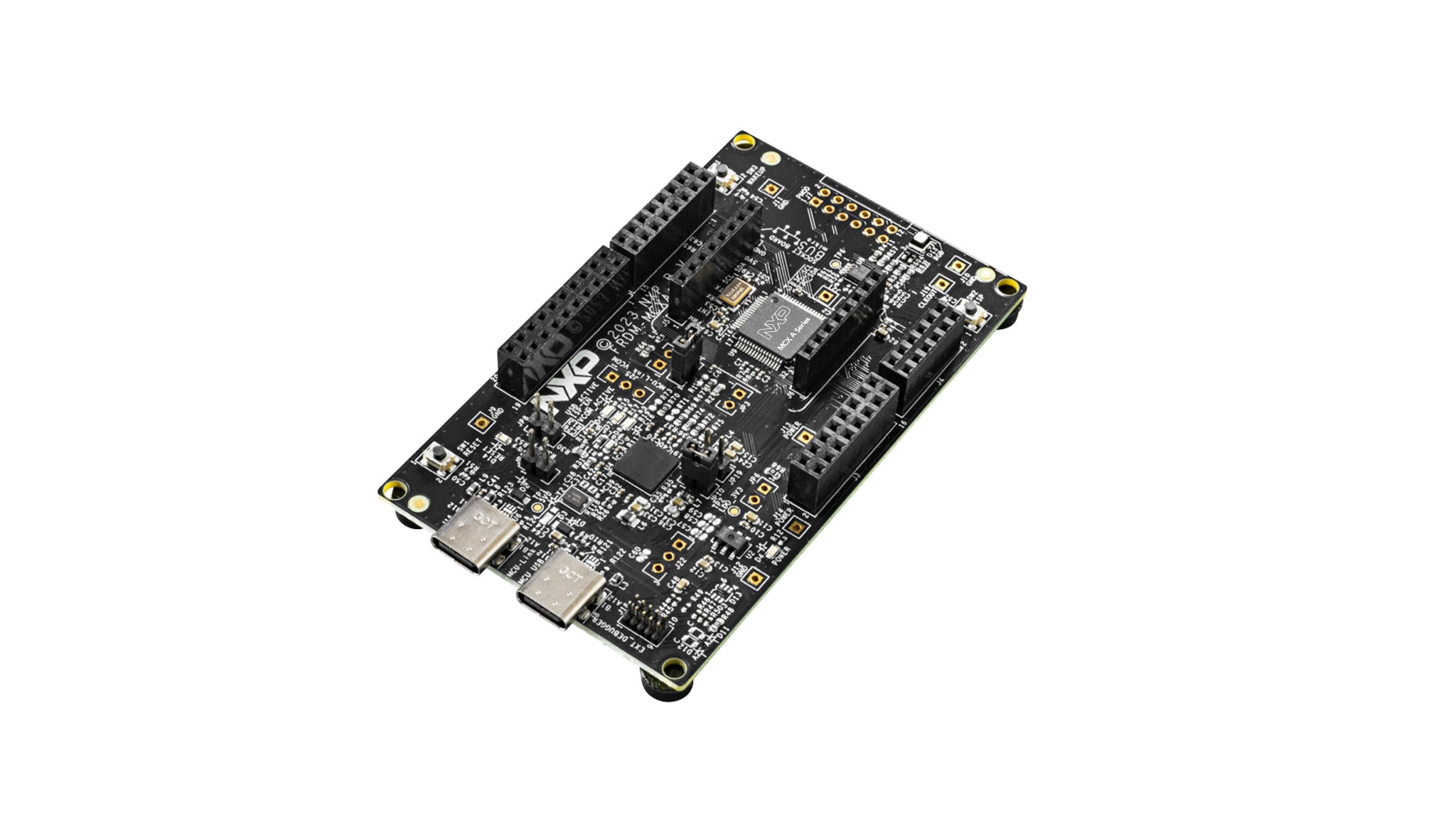 FRDM-MCXA153 Development Board
FRDM-MCXA153 Development Board
The FRDM platform was popular amongst developers for many years. It provides easy access to IO via Arduino®
compatible pin headers. Extra rows of pins are provided for complete access to MCX A peripherals. Also included are sockets for
mikroAlso included are sockets for BUS as well as
Digilent PMOD™. There are
compatible expansion boards and “shields” available at the
Expansion Board Hub (EBH).
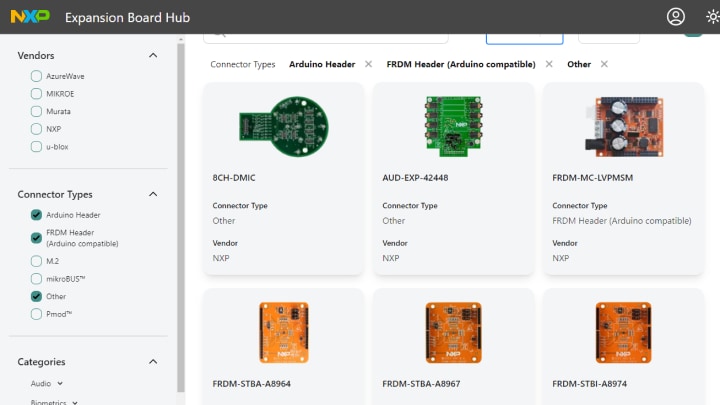 NXP’s Expansion Board Hub
NXP’s Expansion Board Hub
You can find board and software examples to help during the development process.
In the cases where you cannot find an expansion board to meet your needs, we offer help in building your own. Available in the
NXP
MCX Community is an
MCX A FRDM shield template. This template allows engineers to quickly build their own shields to support their custom use case.
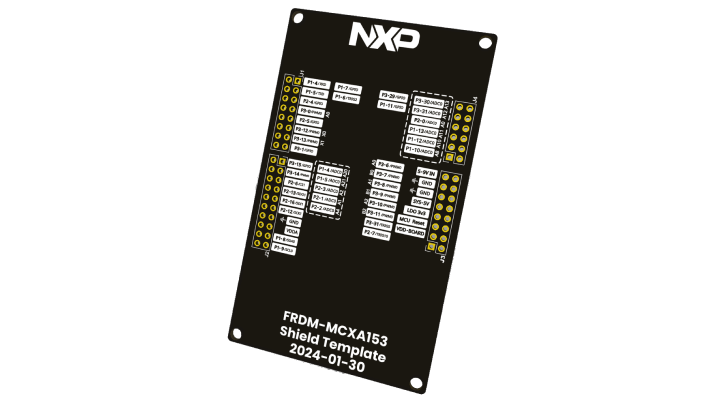 MCX A FRDM shield template
MCX A FRDM shield template
Another development resource that dovetails with the SDK and expansion board hub is the
Application Code Hub
(ACH). The ACH repository has high level software examples, code snippets and demos. These examples pair with the SDK and can be
directly accessed from NXP's IDEs or via the
ACH web interface.
An overview of the Application Code Hub
MCX Scalability Throughout 2024
MCX A is an important part of the
MCX portfolio addressing motor control,
sensing and related industrial applications while having distinguishing peripherals such as MIPI I3C. The MCX A14x and A15x are
just the start. The MCX A Series
will be extended throughout 2024 and beyond, including new families and variants with much more Flash, RAM and retaining pin
compatibility in the packages.
Please visit the MCX A14x and A15x to get
access to datasheets, reference manuals and everything you need to get started.









